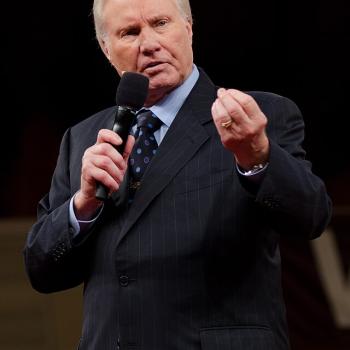Several have asked me here to explain my meaning of “fundamentalism.” That’s difficult to do in a nutshell. Like “evangelicalism” one has to distinguish between the Fundamentalist Movement (or “movement fundamentalism”) and the fundamentalist ethos.
The Fundamentalist Movement is well understood; scholars such as Marsden and Carpenter have recounted its history and distinguishing features. I have interacted with movement fundamentalists over the years by having them visit my classes. One of those speakers (from Central Baptist Theological Seminary in Minneapolis) emphasized that fundamentalism is marked off from other types of Christianity (including neo-evangelicalism) by its militant (not violent) defense of biblical orthodoxy and its doctrine and practice of biblical separation including secondary separation.
The Fundamentalist Movement, in spite of itself, has no definite boundaries because it is a movement and not an organization. It includes organizations such as the American Council of Christian Churches founded by Carl McIntire which became an evangelical rival on the right to the National Association of Evangelicals.
Billy Graham started out in this Fundamentalist Movement but was ostracized from it because of his inclusion of Catholics and “liberal” Protestants in his New York evangelistic crusade in the late 1940s. (All of this is described in detail by Marsden and Carpenter in their books to which I have alluded several times before. Look them up on amazon.com.)
Harold John Ockenga’s “new evangelicalism” emerged out of the Fundamentalist Movement in the 1940s and 1950s. The major differences had to do with cultural engagement (as opposed to separation), a broader perspective on who is evangelical (Ockenga and the NAE included Pentecostals), a greater emphasis on the good of education (even outside of fundamentalist Bible institutions) and an attempt to rebalance the Christian beliefs that properly belong in the “essential” and “non-essential” categories. (Many in the Fundamentalist Movement had come to view premillennialism as an essential of Christian faith.)
The NAE’s statement of faith illustrates well the shift: It does not include the inerrancy of Scripture (although it does use the term infallible for the Bible) or the substitutionary atonement (it says “vicarious sacrifice) or premillennialism.
Throughout the 1950s and 1960s and into the 1970s the new evangelicalism, largely focused on Billy Graham and his ministries (including Christianity Today), and the Fundamentalist Movement went their separate ways with occasional clashes. Both sides took delight in criticizing the other side. Fundamentalists criticized the new evangelicals for being “compromised” (with secular culture and liberal theology) and for seeking respectability. The new evangelicals criticized movement fundamentalists for being narrow minded, anti-intellectual, too separatistic and for majoring in the minors of doctrine and practice.
To make a long story short, during the late 1970s and throughout the 1980s movement fundamentalists such as Jerry Falwell began to call themselves “evangelicals” and the media began to call them that (much to the chagrin of some movement fundamentalists and some new evangelicals). Billy Graham began to decline as the glue holding the new evangelicalism together. The NAE’s influence began to wane. Fundamentalism began to bleed out of its normal zone of separatistic isolation into culture and into evangelicalism. Many conservative evangelicals began to sound more and more like fundamentalists.
One major turning point in this blurring of traditional differences between movement fundamentalism and the new evangelicalism was Harold Lindsell’s 1976 book The Battle for the Bible that fell like a bombshell on the playground of the evangelicals. It argued that biblical inerrancy (rather narrowly defined) is an essential of evangelical faith if not of Christianity itself. Even Carl F. H. Henry, the “dean” of the new evangelical theologians, disagreed and was dropped as a columnist from Christianity Today. (Henry had been the founding editor of CT; Lindsell was one of his successors.)
However, numerous evangelical pastors, denominational leaders, parachurch organization leaders and administrators of evangelical colleges, universities and seminaries either agreed with Lindsell or were cowed into seeming to agree with him by pressure from constituents.
A personal, illustrative anecdote. When I enrolled in an evangelical seminary in 1975 it did not have a statement on inerrancy and, to the best of my knowledge, none of the faculty believed in biblical inerrancy. They talked about biblical infallibility but distinguished that from inerrancy. They talked about inerrancy as a fundamentalist view of the Bible and preferred to adhere to the Bible’s full authority for faith and practice. This was a mainstream evangelical seminary, not at all to the “left” or influenced by liberalism. It did have a Pietist background, however, which inclined it toward a more generous orthodoxy (not a term coined by McLaren!).
After The Battle for the Bible was published, while I was still in seminary, the denomination’s pastors pressured the seminary to adopt a binding statement of the Bible’s inerrancy in the original autographs. The faculty were asked to sign it. I noticed that several of my professors who had criticized inerrancy in class signed it to keep their jobs. One resigned and went on to a stellar career in American and Canadian Baptist seminaries. The ethos of the seminary changed. A chill came over the classrooms and student-faculty lounge and chapel. At my graduation a fundamentalist pastor and radio preacher delivered the commencement address, much to the chagrin of most of the faculty and students.
It isn’t so much that movement fundamentalists switched sides or joined new evangelical organizations. It’s that some among the new evangelicals began to sympathize with SOME features of fundamentalism and regret evangelicalism’s movement away from it.
The Fundamentalist Movement still exists in relatively clear distinction from the post-WW2, postfundamentalist evangelical movement. The distinction still has to do with separationism and especially secondary separation. Even the most conservative, neo-fundamentalist evangelicals rarely practice secondary separation. Billy Graham is still their hero and they claim him even if some of his specific views are not popular among them.
However, what I call a fundamentalist ethos has bled out of movement fundamentalism and begun to have a pernicious influence among people who are heirs of the original postfundamentalist evangelical founders and leaders. I call this “neo-fundamentalism.” It is beginning to coalesce as a distinct movement within evangelicalism and is attempting to take over the entire evangelical movement (as it did the Southern Baptist Convention).
What are the distinguishing features of neo-fundamentalism?
First, a certain militancy in defense of perceived evangelical doctrinal tradition. Self-appointed spokespersons for neo-fundamentalism are actively seeking to get those evangelicals they consider doctrinally impure or compromised fired from evangelical organizations and not published by evangelical publishers. They congratulate each other and give each other pats on the back for pointing out heresy or heterodoxy where it has not yet been recognized. Their practice of theology is almost exclusively critical; they see no value in constructive or reconstructive theology even if it is based on fresh and faithful biblical research. They are militant defenders and promoters of something they call “the received evangelical tradition” (or by another name).
Second, a certain mean-spiritedness toward fellow evangelicals who disagree with them. Many of these neo-evangelicals see nothing wrong with misrepresenting their opponents’ views in order to marginalize them. (I have myself been subjected to this frequently and could cite names, but that’s not my goal here.) One well-known and highly regarded neo-fundamentalist evangelical theologian tried to get a colleague fired for allegedly not believing rightly in the resurrection. (According to him it has to be “physical,” “bodily” is not enough.) The same man wrote a book claiming that open theism borrows from process theology and cited pages in an open theists’ book to prove it. Anyone who looked up those pages could easily see the open theist author denied influence by process theology while only admitting similarity on one point–God’s knowledge of the future.
Third, a tendency to fill up the “essentials” (dogmas) category of Christian beliefs with non-essentials. For example, many neo-fundamentalists are claiming that substitutionary atonement is an essential of Christian faith. Even the NAE statement of faith doesn’t mention it! Some are claiming that inclusivism is in direct conflict with basic Christian doctrine. (They conveniently overlook that C. S. Lewis was an inclusivist as is Billy Graham.) I could go on mentioning secondary doctrines that neo-fundamentalists within the evangelical movement are contending for in a somewhat militant manner even to the point of questioning the salvation of those who do not believe them.
Fourth, a new version of separationism. Neo-fundamentalists don’t often practice secondary separation. But it is beginning to raise its ugly head among them. One example is the Southern Baptist Convention’s withdrawal from the World Baptist Alliance. Neo-fundamentalists are doing their best to take over organizations traditionally related to the broader “new evangelicalism” movement, but when they can’t, they are beginning to found their own separate organizations to compete with evangelical ones.
What I see emerging, that in my opinion is not being recognized by most evangelical leaders, is a third way–a via media between movement fundamentalism and the postfundamentalist evangelicalism. People from movement fundamentalism are emerging out of their isolation into this third way and calling it “conservative evangelicalism.” People from postfundamentalist evangelicalism are adopting this third way and calling it “conservative evangelicalism.” THIS is why I call myself a postconservative evangelical. It has NOTHING to do with being liberal; it has everything to do with not wanting to be confused with these people creating and populating this third way via media. I simply refuse to give up the label “evangelical,” but because of the growing influence of this third way I have to use some adjective to distinguish my own way of being evangelical from that.
More to come….












